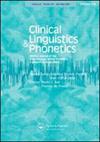患有和未患有自闭症谱系障碍(ASD)的阿拉伯语儿童的非单词重复:仔细研究准确性和错误模式。
IF 1
4区 医学
Q4 AUDIOLOGY & SPEECH-LANGUAGE PATHOLOGY
引用次数: 0
摘要
非词重复(NWR)任务可有效识别语言障碍,并评估不同人群和语言(包括阿拉伯语)的语音技能。先前的研究显示,自闭症谱系障碍(ASD)儿童在非词重复(NWR)任务上的表现存在差异。本研究首次采用巴勒斯坦-阿拉伯语 NWR 任务,对患有和未患有 ASD 的巴勒斯坦-阿拉伯语儿童的语音技能进行评估。共有 142 名 5-11 岁讲巴勒斯坦阿拉伯语的儿童参加了研究,其中包括 75 名典型语言发育(TLD)儿童和 67 名 ASD 儿童。NWR 任务包括 18 个不同长度(1-4 个音节)和复杂程度(有辅音群和无辅音群)的非单词。定量分析检验了长度和语音复杂性对 TLD 和 ASD 儿童 NWR 准确性得分的影响。错误模式分析包括音素和音节的替换/删除/添加以及词汇化,旨在揭示患有和未患有 ASD 儿童的语音表征。在 ASD 群体中,出现了两个亚群:72% 的儿童表现出与年龄相适应的 NWR 性能,而 28% 的儿童表现出语音障碍的风险。非词的长度而非复杂程度对儿童的表现有重大影响。辅音替换是所有组别中最常见的错误模式。在理论方面,这些发现将 ASD 儿童语音技能异质性的跨语言证据扩展到了讲阿拉伯语的儿童。此外,这些发现还突显了 ASD 儿童语音发展的整体延迟但质量相似的模式。在临床方面,研究结果强调了对 ASD 儿童进行全面语言评估的重要性。本文章由计算机程序翻译,如有差异,请以英文原文为准。
Non-Word Repetition in Arabic-speaking children with and without Autism Spectrum Disorder (ASD): A closer look into accuracy and error patterns.
Non-Word Repetition (NWR) tasks effectively identify language impairments and assess phonological skills across diverse populations and languages, including Arabic. Prior research revealed heterogeneity of performance in children with Autism Spectrum Disorder (ASD) on NWR tasks. The current study is the first to evaluate phonological skills of Palestinian-Arabic-speaking children with and without ASD, employing a Palestinian-Arabic NWR task. A total of 142 Palestinian-Arabic-speaking children, aged 5-11 participated in the study, including 75 children with Typical Language Development (TLD) and 67 children with ASD. The NWR task included 18 non-words of varying length (1-4 syllables) and complexity (with and without consonant clusters). Quantitative analysis examined the effects of length and phonological complexity on the NWR accuracy scores in children with TLD and ASD. Error pattern analysis accounting for phoneme and syllable substitutions/deletions/additions and lexicalisations aimed to shed light on the phonological representations of children with and without ASD. Within the ASD group, two subgroups emerged: 72% exhibited age-appropriate NWR performance, while 28% showed performance at-risk for phonological impairment. Non-word length, rather than complexity, significantly influenced the children's performance. Consonant substitution was the most frequent error pattern across all groups. On the theoretical side, these findings extend cross-linguistic evidence of phonological skill heterogeneity in children with ASD to Arabic-speaking children. Additionally, they highlight an overall delayed but qualitatively similar pattern of phonological development in children with ASD. On the clinical side, results underscore the importance of comprehensive language assessment in children with ASD.
求助全文
通过发布文献求助,成功后即可免费获取论文全文。
去求助
来源期刊

Clinical Linguistics & Phonetics
AUDIOLOGY & SPEECH-LANGUAGE PATHOLOGY-REHABILITATION
CiteScore
2.70
自引率
16.70%
发文量
74
审稿时长
6-12 weeks
期刊介绍:
Clinical Linguistics & Phonetics encompasses the following:
Linguistics and phonetics of disorders of speech and language;
Contribution of data from communication disorders to theories of speech production and perception;
Research on communication disorders in multilingual populations, and in under-researched populations, and languages other than English;
Pragmatic aspects of speech and language disorders;
Clinical dialectology and sociolinguistics;
Childhood, adolescent and adult disorders of communication;
Linguistics and phonetics of hearing impairment, sign language and lip-reading.
 求助内容:
求助内容: 应助结果提醒方式:
应助结果提醒方式:


